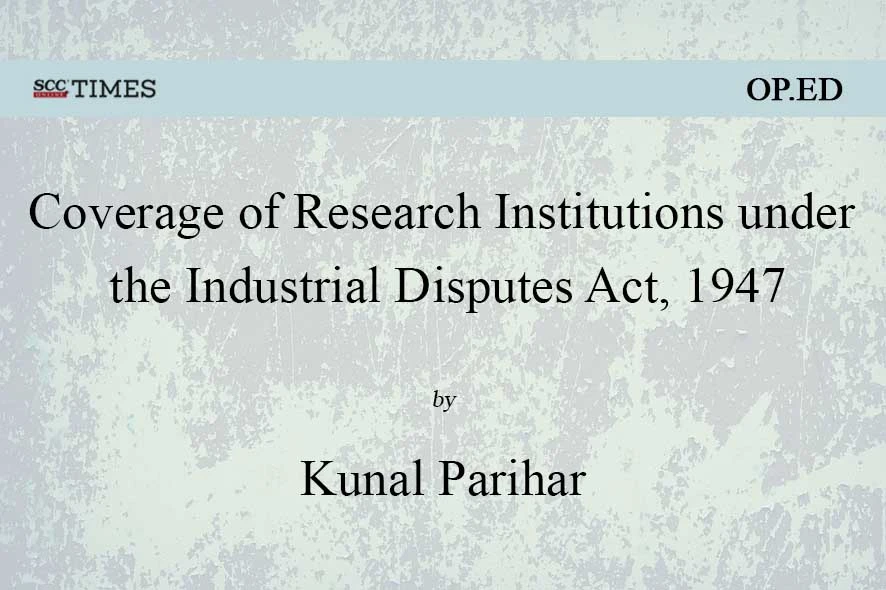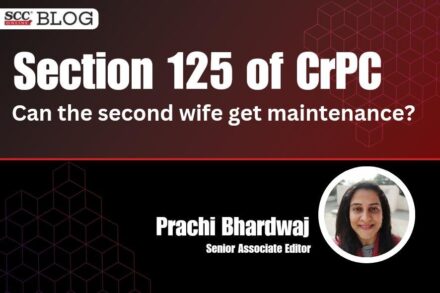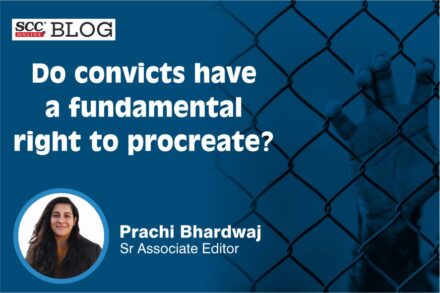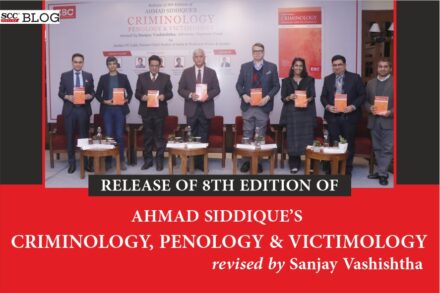Introduction
India’s journey towards rapid industrialisation and globalisation has led to phenomenal increase in the investments from the global community, morphing the economic landscape of the nation.1 The notion of “industry” has extended beyond its conventional meaning and now also includes institutions involved in research and employing scientists, para-scientists, and various other employees.2 This evolution of the term means that the labour laws are more relevant than ever to attend to the challenges faced by the employees in various kinds of establishments across the country. One of the primary labour law statutes in India that addresses these challenges is the Industrial Disputes Act, 1947 (the Act), enacted with the purpose of resolving industrial disputes.3 The definition of “industry” under Section 2(j) of the Act4 is crucial in deciding whether a particular activity comes under the Act and accordingly what rights and protections are granted to the workers.5 Thus, whether research institutions come within the scope of the Act depends on whether it is an industry or not. Although the Act provides for the definition, the courts have interpreted it extensively over the years.6
This paper will critically examine the ambiguities surrounding the inclusion of research institutions in the definition of “industry” under the Act, analysing judicial decisions and legislative interventions. Firstly, the paper will trace the evolution of the term “industry” as defined in Bangalore Water Supply and Sewerage Board v. A. Rajappa (BWSS)7 and will also investigate the subsequent developments. It will highlight the problems that emerged concerning research institutions after the decisions in Physical Research Laboratory v. K.G. Sharma (PRL)8 and State of U.P. v. Jai Bir Singh (Jai Bir Singh)9 which deviated from the principles laid down in BWSS10 and questioned the authority of the same. Secondly, the paper will argue that despite these decisions, BWSS11 is still a binding precedent with respect to the interpretation of research institutions as industries. Thirdly, this paper will examine the new Industrial Relations Code, 2020 (the Code)12, highlighting the grey areas in the definition of “industry” and its implications for research institutions in future. Lastly, this paper will conclude by calling for legislative intervention to settle the ambiguities as well as clarify the position of research institutions under the new Code.
Research institutions and the evolving definition of “industry” under the Industrial Disputes Act, 1947
The term “industry” under the Act has been interpreted in various ways by the courts over the years.13 As per Section 2(j) “industry” means “any business, trade, undertaking, manufacture or calling of employees and also includes any calling, service, employment, handicraft, or industrial occupation or avocation of workmen”.14 The word “undertaking” which is key to this definition has a wide connotation, meaning any activity or project of an entity. But it is limited by the condition that it should be analogous to a business or trade.15
One of the landmark cases in respect of interpreting the term “industry” and dealing with the scope of coverage of research institutions under the Act is BWSS decision, where a seven Judge Bench of the Supreme Court articulated the triple test to determine whether an activity qualifies as an industry.16 The test classifies an activity as an industry if there is the presence of any systematic effort made through collaboration between employers and employees geared toward the production or distribution of goods or services.17 Importantly, an activity that satisfies the above test is considered an industry even if there is no gain motive, except when it is a part of the sovereign function of the State.18 Justice Krishna Iyer, in his majority opinion, expanded this definition to include research institutions and said that they can also be considered industries if they meet the criteria laid down by the test.19 As per him, scientific research can bring huge societal benefits to the country, to technology, and to industry at large, and that these activities are industrial even when there is no direct profit motive involved.20
After this judgment, the Government passed the Industrial Disputes (Amendment) Act, 198221 to redefine the term “industry”, excluding hospitals, educational and research institutions, and organisations engaged in charitable or philanthropic work.22 The reason for this exclusion was to preserve their unique institutional set-up and special needs which are different from industrial establishments. But despite this amendment being enacted more than four decades ago, it has not been notified by the executive yet.
The main source of confusion regarding research institutions being considered as “industry” arose with the ruling in PRL where a two-Judge Bench of the Supreme Court excluded research institutions engaged in pure non-commercial research from the definition of industry even though such institutions fulfilled all the criteria of the triple test.23 This decision went against BWSS case which had held that the profit motive or commercial character of the institution is not relevant to determine whether an institution is an industry. Instead, the key factors to consider were the nature of work and the relationship between the employer and employees.24 However, PRL case25 introduced the commercial character of research institutions as a determining factor, creating a contradiction with the existing legal framework.
Further complexity arose with the Supreme Court ruling in Jai Bir Singh26, which not only questioned the precedential value of BWSS judgment27 but also cast doubt on the substantive worth of the triple test and its applicability to research institutions.28 The five-Judge Bench suggested reconsidering the principles laid down in BWSS29 as the majority opinion of Justice Krishna Iyer did not fully address the dissenting views of Justices Beg and Chandrachud.30 The Court criticised extending the Act to activities like research institutions that involvement use of intellectual attainments, talent and skill, stating that these institutions do not operate like traditional industries.31 Imposing such a definition unfairly burdens employers and creates an imbalance by prioritising worker interests over the unique needs of non-industrial organisations.32
As a result of PRL33 and Jai Bir Singh34 rulings, significant uncertainty has been introduced regarding what could be characteristics that are required to term research institutions as an “industry” under the Act. Should courts follow PRL35 approach which considers the commercial character of research institutions to determine if it is an industry? Or should the more inclusive interpretation of BWSS case36 be followed which does not consider profit motive as a determinant? This lack of clarity is further compounded by Jai Bir Singh case37 which has doubted the authority of BWSS judgment38. Thus, there is a need for an urgent clarification on this ambiguity as it is not only important for resolving industrial disputes but also for protecting the rights of employees working in such research institutions.
Which to follow — BWSS or PRL?
Jai Bir Singh case39 has created a dilemma regarding the meaning of the word “industry” in respect of research institutions and which precedent to follow. But it is arguable that despite its harsh criticism of BWSS ruling40, Jai Bir Singh decision41 does not fully undermine the authority or the substance of the triple test. This is because the separate opinions of Justices Beg and Chandrachud, though differed on some points, did not reject the basic principles of BWSS42, particularly the triple test.
Firstly, the decision of the court that there is no authoritative value in BWSS judgment43 seems to misread the separate opinions of Justice Beg and Justice Chandrachud as being in complete opposition to the triple test propounded by Justice Krishna Iyer. Justice Beg, though was not able to elaborate on the various judgments cited, agreed with the conclusion that the Board was an “industry” and also endorsed the test.44 His reservations were limited to the sovereign function debate, particularly his discomfort with the terminology used and not with the idea of having sovereign functions as an exception to the definition of “industry”.45 Similarly, Justice Chandrachud’s separate opinion also did not reject the triple test in toto. While he took a more maximalist view by stating that industry should not be restricted by excluding certain activities like sovereign functions, he did not dispute the core of the test to determine whether an institution is an industry or not.46 Thus, the separate opinions of both Justices, though differed on the scope of sovereign functions, accepted the majority opinion in BWSS decision.47
Secondly, the ruling in Coir Board v. Indira Devi P.S.48 was criticised for asking for reconsideration of BWSS judgment49 without any material evidence.50 The Court in Coir Board51 held that extending the scope of the Act to unintended organisations would lead to industrial unrest and curtailment of employment opportunities52 but this was not supported by any evidence by the court. Critics argued the benefits of worker protection and fair labour practices may outweigh the alleged negative impacts.53 Jai Bir Singh decision54, while responding to the criticisms against Coir Board55, pointed out that worker rights are being over-emphasised by the triple test and cited back wages as an example to explain how broad interpretation is harming industrial relations.56 The Court ruled that large awards for wrongful termination while compensatory often burden resource-poor employers, especially the smaller industries.57
But it is arguable that the example of back wages in Jai Bir Singh case58 fails to challenge the foundation of the triple test. Presently, awarding back wages is no longer the norm in labour law, courts have the discretion to grant alternative reliefs like reinstatement without back wages or compensation in lieu of reinstatement.59 The decision to award back wages is discretionary and depends on the facts of each case, like the legality of termination or retrenchment.60 Moreover, back wages are a consequence of illegal or wrongful actions of employers, it would not be fair to use such instances to revisit the entire framework of the test. Hence, given the above arguments, it can be concluded that Jai Bir Singh decision61 does not provide any substantial or concrete ground to question the authority of BWSS.62
Upon analysing the reasoning in PRL case, the conclusion of the court that the institution is purely engaged in research and does not provide services to others, therefore it does not come within the definition of “industry”63 does not seem to have any substantial basis. BWSS did not require immediate application of research for the commercial motive. Research, even if not immediately used for tangible products or services, has long-term social benefits and adds to the wealth of the nation.64 Moreover, the triple test in BWSS is about the production of goods or services regardless of immediate sale or use.65 So, institutions doing research should not be excluded just because their outputs are not commercialised immediately. Thus, despite the judgments in PRL66 and Jai Bir Singh67, the core principle laid down in BWSS judgment68 still holds good and the triple test remains a definitive standard to determine whether a research institution is an “industry” under the Act or not.
Industrial Relations Code, 2020 and the grey area surrounding research institutions
The Industrial Relations Code, 2020, which is going to replace the Act aims to consolidate and amend laws related to trade unions, employment conditions in industrial establishments, investigation and settlement of industrial disputes, and other related matters.69 The laws prevailing before the introduction of the Code were considered to be outdated and inconsistent. The Bills were introduced in 2019 in adherence to the recommended bifurcation but were replaced on 28-9-2020 when the Government notified the Code to modernise India’s labour and employment laws. Although the Code has been enacted, it is yet to come into effect.70
The Code has amended the definition “industry” in harmony with BWSS decision71, making it more exhaustive.72 It has also changed the definitions of the term “worker”, “employee” and “employer” so that they can be more extensive.73 Unlike the 1982 Amendment, which explicitly excluded research institutions from the definition,74 the Code does not have such an exclusion. Instead, it excludes “institutions owned or managed by organisations primarily engaged in charitable, social or philanthropic services”.75
However, this revised definition creates uncertainties regarding the position of research institutions and how they will be classified under the new law. Since research institutions are automatically deemed as “industry” if they meet the criteria laid down in the definition, it raises questions as to how we then distinguish between those institutions doing non-commercial research that falls under the ambit of “industry” from those associated with organisations doing social or charitable work and are exempted from the definition. The insertion of the words charitable and social in the definition with any clear boundaries may result in confusion and has the possibility of being misused as these words are not explicitly defined in the Code.76 This ambiguity creates a grey area in the implementation of the Code on certain types of institution, mainly research institutions working in the non-profit social sectors.
Moreover, the absence of a three-tier distinction for charitable and social services as was done in BWSS case, makes the new legislation more difficult to navigate. BWSS judgment created a framework to determine if the Code applies to such institutions by looking at the primary purpose and scope of the activities.77 The Code does not replicate this nuanced approach and therefore does not address the complexities in classifying institutions that provide charitable or social services. While the broader definition of “industry” under the Code may cover more activities, the exemption for institutions primarily involved in such services creates an unintended hole. This could result in many workers employed in research or similar institutions being excluded from the protections and enjoyment of rights under the Code despite their work falling under the definition of “industry”.
Furthermore, for research institutions that are exempted under the definition itself due to them being owned or managed by organisations rendering charitable or social services, a critical issue arises as to the protection of the rights of the employees working in such institutions. The legislature has not provided any alternative legal mechanism or special law to address the grievances of these employees. As submitted by the Union in Aeltemesh Rein v. Union of India, the reason the amended definition of 1982 was not notified at that time because there was no framework to deal with the grievances of employees working in exempted activities like research institutions.78 Since there is no central law to protect these workers yet, millions of employees of research institutions will not be covered under the new Code as a consequence of being exempted from the ambit of the definition.
Conclusion
The principles laid down in BWSS judgment79 are still binding and the broad definition of “industry” covers research institutions that meet the criteria of the triple test. One question that might come up in this debate is whether such a broad definition is ultimately beneficial for research institutions in the long run? In this context, Alan Hyde’s framework is a useful tool to decide whether labour law should apply to a particular sector, like research institutions, or not.80 The framework asks three questions: (1) what barriers to socially optimal solutions exist in the market; (2) can collectivisation, socially provided contractual minima or dispute resolution mechanisms address these barriers; and (3) are the social costs of labour law outweighed by the benefits?81
Applying this to research institutions, firstly, several barriers can be located to socially optimal solutions. This involves power imbalances between employers and researchers, limited bargaining power due to niche expertise and competitive job markets, and precarious employment due to short-term funding cycles. Secondly, these barriers prevent fair treatment and create conditions for exploitation. Inclusion of research institutions in the definition of “industry” can address these issues by giving researchers collective representation, fair treatment through mandatory contractual standards like minimum wage and working hours along with accessible dispute resolution mechanisms. Thirdly, while this may incur short-term administrative costs or reduced flexibility, the long-term benefits are much greater, including better morale, higher productivity, increased talent retention, and a fairer workplace culture.
Regarding the new Code, there is an urgent need for intervention and clarification from the legislature. A relook of the definition is needed to ensure that workers in the industry continue to benefit from industrial laws while philanthropic and charitable services to the community are not affected. It must shed light on the difference between social/charitable services and research institutions that are not for profit but still fall under the definition of “industry”. With the disinvestment policies ongoing and many public research institutions being privatised,82 it is becoming more and more urgent to resolve these existing ambiguities around their classification as industries. As these institutions move into the private sector, we need to clarify their legal and regulatory status so that not only private investment interests but also the rights of the worker are protected who, if excluded from the definition, will find themselves in a situation of helplessness. The legislature must consider creating specific legal frameworks or mechanisms to address the grievances of employees in research institutions which will be exempted from the Code due to their charitable or social service nature.
*Student, National Law School of India University, Bangalore.
1. Suhani Gupta and Muskan Sethi, “Case Comment: Bangalore Water Supply & Sewerage Board, etc. v. R. Rajappa” (2022) 3.1 JCLJ 1631.
2. Ahmedabad Textile Industry’s Research Assn. v. State of Bombay, 1960 SCC OnLine SC 152.
3. Industrial Disputes Act, 1947.
4. Industrial Disputes Act, 1947, S. 2(j).
5. D.W. Wadegaonkar, “Concept of Industry”, (1981) 23(3) Journal of the Indian Law Institute 400.
6. D.W. Wadegaonkar, “Concept of Industry”, (1981) 23(3) Journal of the Indian Law Institute 400.
12. Industrial Relations Code, 2020.
13. Saurabh Bhattacharjee, “In Defence of the Triple Test: A Case for Retaining the Standard in Bangalore Water Supply (Part I)” (lawandotherthings.com, 25-11-2016).
14. Industrial Disputes Act, 1947, S. 2(j).
15. State of Bombay v. Hospital Mazdoor Sabha, 1960 SCC OnLine SC 44, para 8.
16. BWSS, (1978) 2 SCC 213, para 140.
17. BWSS, (1978) 2 SCC 213, para 140.
18. BWSS, (1978) 2 SCC 213, para 140.
19. BWSS, (1978) 2 SCC 213, paras 112-133.
20. BWSS, (1978) 2 SCC 213, para 133.
21. Industrial Disputes (Amendment) Act, 1982.
22. Industrial Disputes (Amendment) Act, 1982, S. 2(j).
23. PRL case, (1997) 4 SCC 257, para 12.
24. BWSS case, (1978) 2 SCC 213, para 140.
28. Saurabh Bhattacharjee, “In Defence of the Triple Test: A Case for Retaining the Standard in Bangalore Water Supply (Part II)” (lawandotherthings.com, 25-11-2016).
30. Jai Bir Singh case, (2005) 5 SCC 1, para 46.
31. Jai Bir Singh case, (2005) 5 SCC 1, para 35.
32. Jai Bir Singh case, (2005) 5 SCC 1, para 33.
44. BWSS case, (1978) 2 SCC 213, para 149.
45. BWSS case v. (1978) 2 SCC 213, paras 163, 164 & 168.
46. BWSS case, (1978) 2 SCC 213, para 179.
50. Jai Bir Singh case, (2005) 5 SCC 1, para 35.
52. Coir Board case, (1998) 3 SCC 259, para 19.
53. Jai Bir Singh case, (2005) 5 SCC 1, para 35.
56. Jai Bir Singh case, (2005) 5 SCC 1, para 35.
57. Jai Bir Singh case, (2005) 5 SCC 1, para 35.
59. Hari Nandan Prasad v. Food Corporation of India, (2014) 7 SCC 190, para 20.
60. Hari Nandan Prasad case, (2014) 7 SCC 190, para 20.
61. Jai Bir Singh, (2005) 5 SCC 1.
63. PRL case, (1997) 4 SCC 257, para 12.
64. BWSS case, (1978) 2 SCC 213, para 133.
65. BWSS case, (1978) 2 SCC 213, para 140.
66. PRL case, (1997) 4 SCC 257.
67. Jai Bir Singh case, (2005) 5 SCC 1.
68. BWSS case, (1978) 2 SCC 213.
69. Industrial Relations Code, 2020.
70. Sneha Varghese, “The Industrial Relations Code, 2020: Legislative Commentary” (2022) 5(1) International Journal of Law Management & Humanities 1924-1928.
71. BWSS case, (1978) 2 SCC 213.
72. Industrial Relations Code, 2020, S. 2(p).
73. Industrial Relations Code, 2020, Ss. 2(zr), (l) and (m).
74. Industrial Disputes (Amendment) Act, 1982, S. 2(j).
75. Industrial Relations Code, 2020, S. 2(p)(ii)(i).
76. Working People’s Charter, “Why the New Labour Codes Leave India’s Workers Even More Precariously Poised Than Before” (scroll.in, 23-9-2020).
77. BWSS case, (1978) 2 SCC 213, paras 102-104.
78. Aeltemesh Rein case, (1988) 4 SCC 54.
80. Alan Hyde, “What is Labour Law?” 2006 Cornell Legal Studies Research Paper No. 06-10, 17 (papers.ssrn.com, 12-4-2006).
81. Alan Hyde, “What is Labour Law?” 2006 Cornell Legal Studies Research Paper No. 06-10, 17 (papers.ssrn.com, 12-4-2006).
82. Department of Investment and Public Asset Management, “Total Receipts” (dipam.gov.in).






